The BioMachine 2021 Design Challenge was an opportunity for students to identify and research issues that were important to them and then design their own sustainable solution through art and science. Middle and high school students from Taos, Santa Fe and Albuquerque participated. Students were asked to use biomimicry to design an imaginative ‘BioMachine’ that explored the topic of biodiversity loss and pollinator decline and its importance to our community, our food security and the health of our planet. The teachers were given the online BioSTEAM Curriculum Tool with a biomimicry curriculum derived from our guest BioSTEAM artist, Ana MacArthur, whose installation at Taos Land Trust called Pollinator Concentrator, inspired this design challenge. Teachers had to find the time amidst COVID and online learning to integrate the BioSTEAM activity into their core curriculum. Each teacher designed a unique curriculum that integrated the challenge into their subject area i.e. math, science, art, etc.
The BioMachine Design Challenge received a total of 197 student entries which included a drawing and a design statement. The jurors were Ana MacArthur, and Andrea Polli, sci-artist and founder of STEAM NM. The Best of Show prize is $300 and the seven category prizes are $100 each. A $100 Educator Engagement Award goes to the teacher who engages the most students with a comprehensive curriculum design.
The Educator Engagement Award goes to Justine Carryer of Taos High School for most students engaged through a comprehensive curriculum design entitled ‘Applied knowledge of mathematics and its relationship to the natural and biological world.
The School Engagement Recognition goes to TAFT Middle School in Albuquerque New Mexico for best school-wide engagement through a comprehensive curriculum design entitled ‘Honeycomb Design and Sustainable Material.
Special thanks to our our sponsors that made the BioSTEAM project and BioMachine Design Challenge possible.
STEMarts Design Tool
Sky’s Eyes
Otto Manley
Taos Charter School, Grade 8
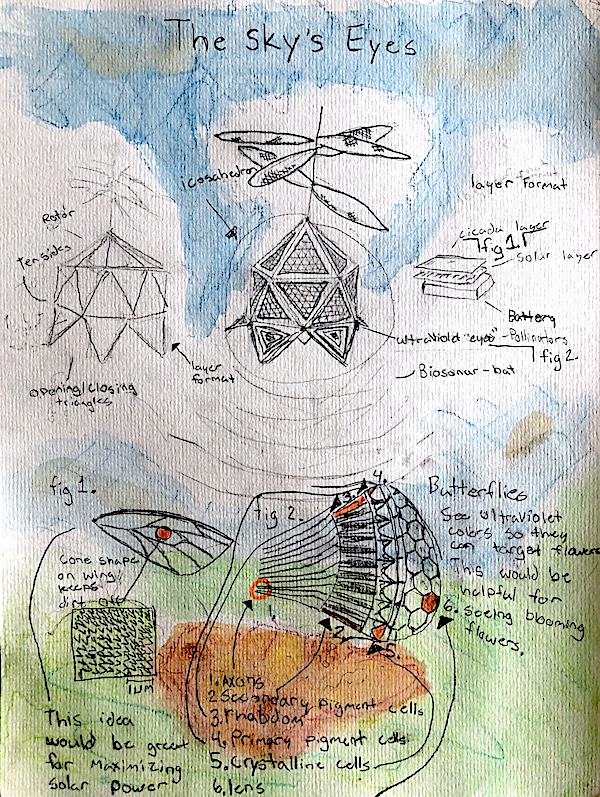
Design Statement: Nature has been figuring out and working on problems forever. We need to start figuring out how to use plants and animals as an answer sheet and use what they know to help us. The intelligent aspects of so many plants and animals can be used to make a bio-machine. I looked far and wide to find plants and animals that had great characteristics to put into a bio-machine. Within my multiple sketches, I figured out a machine that combines most concepts from bats and pollinators. There are a lot of things messed up in this world. What I focused on in New Mexico is migration. My machine is created by 20 triangles creating an icosahedron. This machine uses bat biosonar to see bigger animals like deer, and then it uses butterfly and bee eyesight to see flowers blooming. You can track the pollinators from the pollen. Pollinators help New Mexico vegetables, fruits, and greens. The machine will be helpful because then people can isolate the problem and be sent out to the locations to revive the habitat and make it so that the area can persevere through tough times. It does morally question the rule that you don’t interfere with nature, but because we messed nature up so much, I think it is up to us to fix it. Now for the functionality aspects of my idea. This machine needs to be ultra-light so using futuristic materials is essential. The reason I use the shape of the icosahedron is that if the top is being used by the rotor and the bottom five triangles open up, then it still has ten more sides to reflect against the walls to increase range. It has three propellers on the top to increase stability. Powered by a rotor on the top five triangles, this does take a lot of power so the walls of the machine have internal batteries covering all 20 triangles. The walls have a layer of clear cicada wing structure on the outside and a solar panel underneath that supports a battery under both. Cicada wings have a very clean structure, which will be useful because it creates a protective layer to cover the solar panels. This information needs to be stored somewhere so I think that it should have a long broadcasting range and be able to send it to the nearest “station.” If the machine crashes it will be fine, because it can always use the solar panels to collect sunlight and recharge the batteries. I think that this machine will help New Mexico and will help us turn the world around.
Humliniya Flower
Savannah Romero
Taos Magnet School and Upward Bound Math and Science, Grade 10
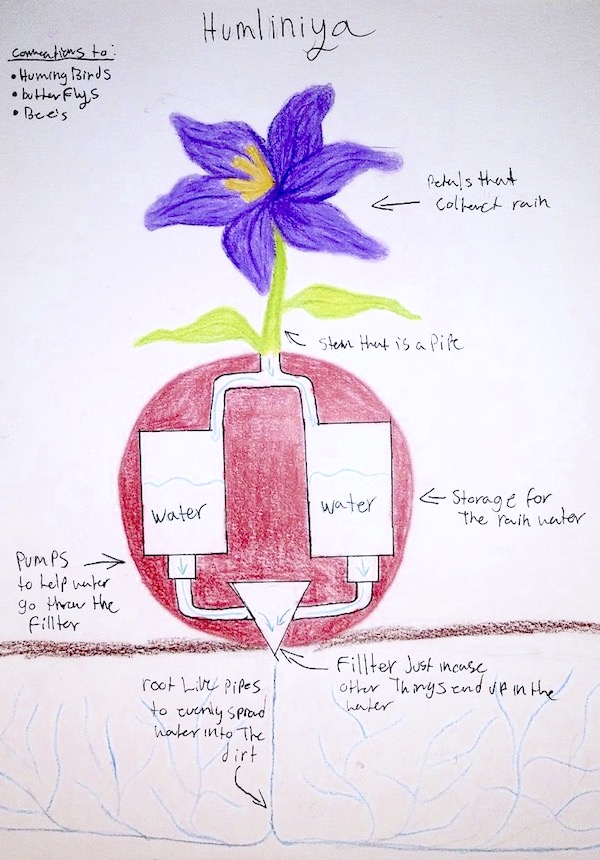
Design Statement: The project was made to filter water from rain and distribute it to plants in the area. The water that would be distributed would occur by a water root system that would evenly hydrate its surroundings. The structure was based on the following pollinators: Bees, hummingbirds and butterflies. The bottom of the project is a dome that is made of hexagons based on bees and the honeycomb structures that they produce. The flower was based on a flower that attracts hummingbirds and butterflies. Both pieces of the project are colored red since it’s a color that stimulates the pollinators’ eyes the most and attracts them to the structure. This machine is an art piece but also a Bio-stem machine that helps pollinator’s spread pollen and make the earth green again. What makes it an art piece is that it symbolizes pollinators and what they use to help grow other plants, aka flowers. This machine was meant to be used in dry areas such as New Mexico; the dirt here is dry and structured a certain way to where only the top layer of dirt gets watered, but the rest is dry. Plants that grow longer roots may not get all the nutrients it needs since the top layer of dirt is the only part that is receiving water. With this project, it can help us spread plant growth.
Sugarbird
Ashlynn DeHerrera
Milagro Middle School,Grade 8
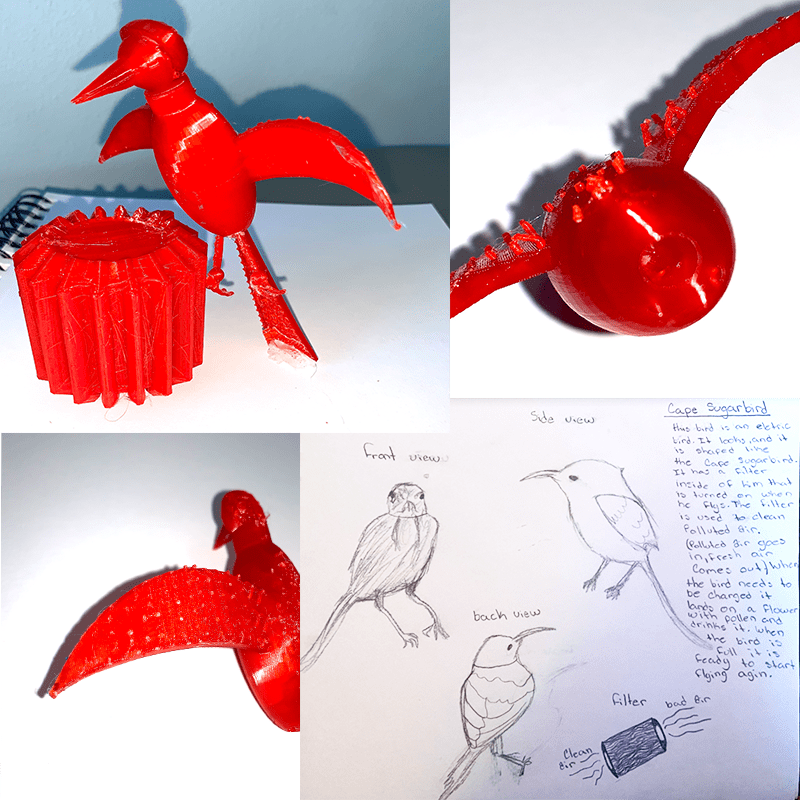
Design Statement: My biomimicry creation is inspired by a Sugarbird. This design not only pollinates but also filters air to help reduce pollution in the air. It is powered by pollen as it flies through the air filtering out particles as it flies through the air. Now, you may be wondering how it does what it does and I’m here to explain to you that there is a filter inside of my pollen powered bird. While the bird is flying the mouth is a little open allowing air to go in. When the air goes in it causes the filter to turn, so the blades will start to spin. Once the air goes in it passes through a purifying filter inside of the bird (doesn’t take long at all) the air comes out and it is all clean. The electric bird is designed after a Sugarbird. It has all of the Sugarbirds features and it also drinks pollen. Actually the bird is powered by pollen. When the bird is flying the pollen is giving it energy but when the bird is all out it lands on one of the flowers it has programmed in his/her system and drinks up. Once it is fully charged again it will take off and start to filter again. This is also the way it acts as a pollinator. The bird is made out of sustainable and recycled materials. Aluminum from cans is a very light metal. This metal is lighter than regulated metals because it is thin and less dense. The wings are made out of a recycled light fabric, recycled wires, and a little bit of wood. All these pieces are connected and once they are the bird has wings. The wings can be powered two different ways one by someone that is good with “drones” or it can be on auto pilot. The tail is made out of feathers that have been found around on the ground and it also has a few light weight metal pieces on it. The design looks and acts like a Sugarbird, and It is less complex. The body is shaped like an oval and the head is round. The design has the same shaped feet as any other bird would have. The wings aren’t as detailed but that’s because with too many things on it it would be too heavy and won’t be able to fly. This can actually be purchased in stores and anyone can fly it and have one. They would be having fun while cleaning the world. It also uses recycled materials so when you buy one you’re filtering the pollution and cleaning up the world. So in closing, who wouldn’t want to have this amazing cool thing! If they go get one at the “Pollinator Sugarbird Headquarters” they can fully customize it with color choices.
MetaStitch
Sasha Kushner & Lilith Safford
Taos High School and Upward Bound Math and Science, Grade 12
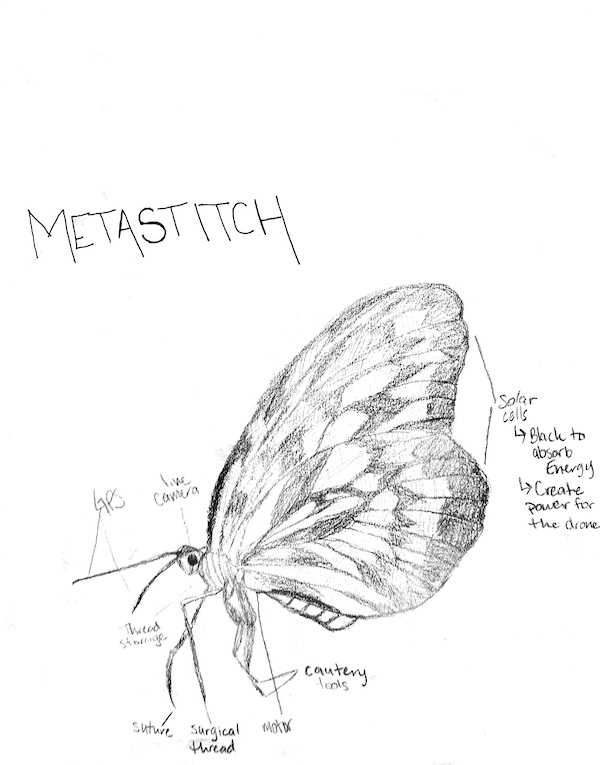
Design Statement: Our Biomachine contributes to the world of emergency medicine. The Biomachine uses only solar power through micro solar panels on its wings. It has the ability to locate wounded soldiers in combat and cauterize their wounds as well as administer stitches until they are able to receive further medical attention. This idea was inspired by our love for medicine and questions that came up between us about how soldiers get access to emergency medical help when they are not able to receive proper medical care. Butterflies are able to see the color red making them able to locate blood and wounds on soldiers in combat. The idea to use the wings as solar panels to create energy came from research on the black wings of the Rose butterfly which can absorb light and create energy. With the invention of these drones, thousands could be sent out into the field and save countless lives.
The DREE
Theo Blaustein & Brandon Mirabal
Taos Charter School, Grade 7
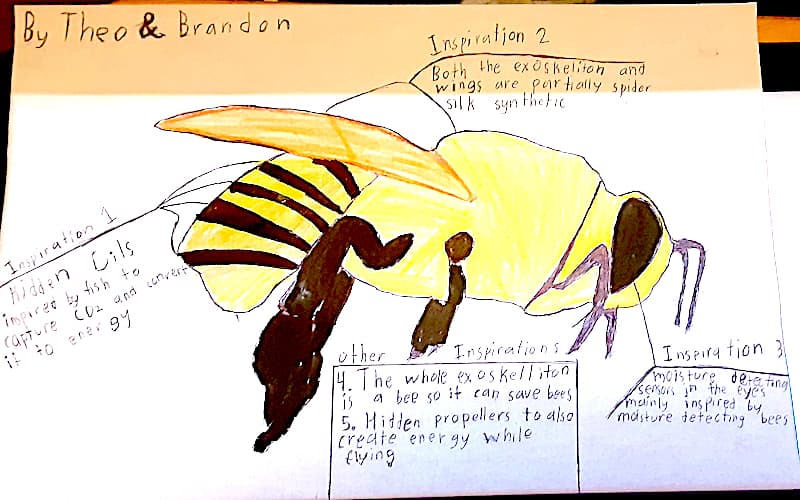
Design Statement: Our team has complete faith that the DREE is the machine to save New Mexico. The adaptor bee population has been suffering a rapid decrease because of this immense drought that New Mexico has been experiencing. The culprit behind the deaths is the fact that the plants New Mexico adaptor bees rely on are dying out. Such plants include the daliah, yucca, and lavender flowers. The DREE is going to help save the adaptor bee population in times of drought by using biomimicry, and high grade technology to increase plant population in areas of moisture in the adaptor bee habitat. It also assists plants in growth, therefore helping everything above in the food chain. To add on top of all of that, it helps increase biodiversity wherever the dree is launched. To sum it up you’re getting four benefits in one machine. We can do all of that, and be cost efficient. The dree is packed with high grade tech that we can funnel into the 250 dollar price per DREE. That means if we can get this to be a government funded project, we could make 10,000 DREES for 2.500,000. Our DREE’s goal is to find areas of moisture within the adaptor bee habitat while in the air. Once that objective is complete, it goes down and plants a calculated ratio of seed species based on the area. Our DREE is programmed to check on the plants every two weeks to record data on the growth. Using bee pheromones, our machine can tell how many bees have been in the area since it was last there, so we can record effective data on progress. Thanks to the exoskeleton being made out of 60% carbon fiber and 40% spider web synthetic, it is very durable. We know that carbon fiber isn’t biodegradable, but New Mexico is one of the poorest States in the country. Luckily, each DREE is fitted with a tracking chip that is highly protected so that if the machine breaks, we can track it, and fix it, so we can reuse every DREE we produce. To run the battery in an eco-friendly way, we use two sources of renewable energy. We mimicked a fish gill in the way that it is shaped as well as the method it uses to capture CO2. So on each side of the machine, we have the gills where the bee stripes usually are. It captures carbon and turns the energy into an AC electric current to power our battery. Our secondary power source is located on the “legs” of the machine: rotating blades that generate energy by spinning when the machine is in the air. Keep in mind that we have mimicked bee wings to fly the machine, not the blades. The blades are there just to generate energy. The DREE is able to see areas of moisture because of lenses that were mimicked from bee eyes. So the machine is able to detect moisture based on color; blue being areas of moisture and red being completely dry, and every color in between. Thanks to the DREE being a drone, it can make up large amounts of distance, for a machine that only weighs 377.7 grams. Since all the factors such as cost and design are so perfect, because we are fortunate to have a great team, we have no doubt in our minds that the DREE will be a huge success. If you take into consideration all the facts that have been bestowed upon you, it is now clear that the DREE will be more than capable of saving the adaptor bee population, and more, by planting seeds in areas of moisture using biomimicry, and its given durability. Since the bee and flower populations are down, we need to take action . We here at DREE Productions believe that with our innovation, we can change the world. But we can’t do it without you, so please help us save New Mexico. With future invitation, hard work and biomimicry, we can make this possible. We hope that the DREE will be an inspiration for other future tech and innovation using biomimicry. So in conclusion, we here at DREE Productions hope that you are ready to see more of us, because we’re not going away any time soon.
Floating Garden
Dominique Vigil
Taos High School, Grade 10
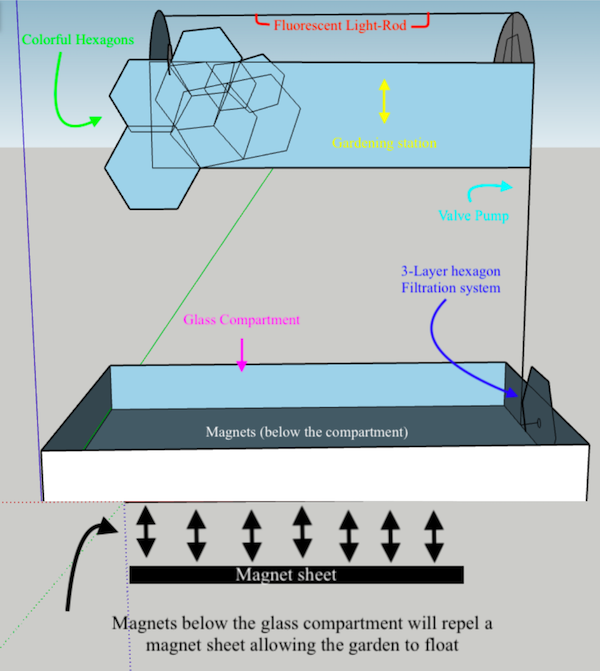
Design Statement: My design will use biomimicry to create a sustainable machine. I am going to create a floating hydroponic- Called a “Floating Garden.” This biomachine collects and filters water. I believe this will solve water waste in gardens and attract pollinators. Using the hexagon shape from honeycomb bees, I will create a reflective shield that will attract bees and reflect larger amounts of sunlight. That material is going to be an acrylic mirror which is considered highly effective. The acrylic glass will be cut into hexagon shapes and colored, allowing the glass to be molded easily. For the base, I will be using a Sulapac (wood-based) material lined with a glass compartment—to prevent leakage. Within the base will be a natural filtration system to filter and dispense fertilizer/Carbon dioxide (algae). The valve pump that supplies the water to the plants will also have a three-layer filtration system. The first layer will consist of gravel, the second layer will incorporate cardboard; which will be used from recycled materials, and the final layer will be an ocean sponge mimicry system that filters pollutants. My biomachine can be placed above a large magnet that will give it a “floating Affect” my garden will attract bees, be self-sufficient, and recycle materials such as wood, glass, and cardboard.
ButterFabric
Grace Carmona Yong
Taos High School, Grade 10
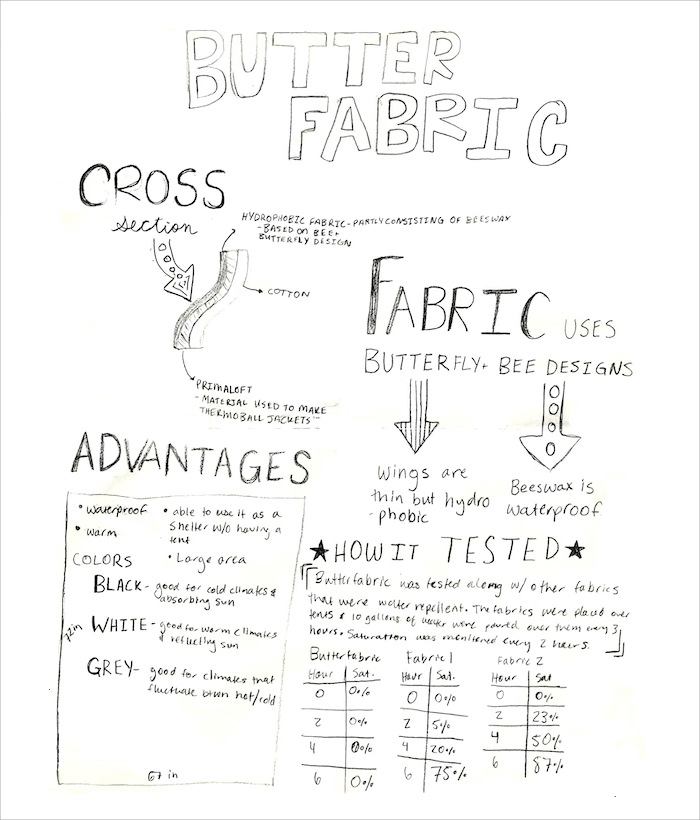
Design Statement: My goal with Butterfabric is to help people. The pollinators that inspired my design were the butterfly and the bee. Butterflies have been discovered to have hydrophobic wings. Moreover, bees produce beeswax, which is a waterproof material. This would also help the fabric be more sustainable. Butterfabric is composed of a warm layer of cotton material on the bottom, followed by an insulating layer, then a hydrophobic layer. The hydrophobic layer is inspired by butterfly and bee designs. I was inspired to create this because of the problem of homelessness. Since it is still winter, I thought I would design a waterproof blanket that people could wear to stay warm and dry. It is big enough to cover a structure that can fit one person. If that person is living in an area with inclement weather or a cold climate, they will stay warm. Butterfabric can also be useful in helping people that are affected by natural disasters to stay warm.
The Seeing Cane
Siena Price
Taos Integrated School of the Arts, Grade 6
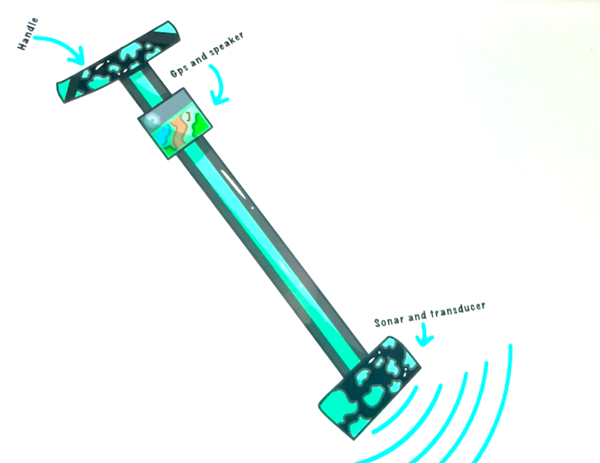
Design Statement: The seeing cane was inspired by bats and can specifically help people who are blind by guiding them using a type of echolocation. The seeing cane has this device on the bottom of the cane that sends out a sonar. Sonar is originally used for underwater research, and sends out a sound pulse. The pulse is sent out from something called a transducer. The sonar is able to detect fairly big objects, rather than something like a bug. After the pulse comes back from whatever it bounced off, the pulse works like echolocation and predicts how far away the object is and what it is. Then there is also a gps that is sound activated so you can find where you want to go. In the center of a transducer is piezoelectric material. The main materials that the piezoelectric material is made of is lead zirconium titanate. The gps would be a regular gps except it can be voice activated. The cane would be the same other than the transducer at the bottom and a device that allows the transducer to tell where things are and what they are. The device in the bottom of the cane that will send out a sonar every time it is tapped on the ground, it will see if there is anything in the way. If it does “see” anything it will tell the person holding it. Such as “There is a car on your left” therefore the person would know not to continue their walk.
BioHex
Lucy Schreiber & Aaliyah Padilla
Taos Charter School, Grade 11
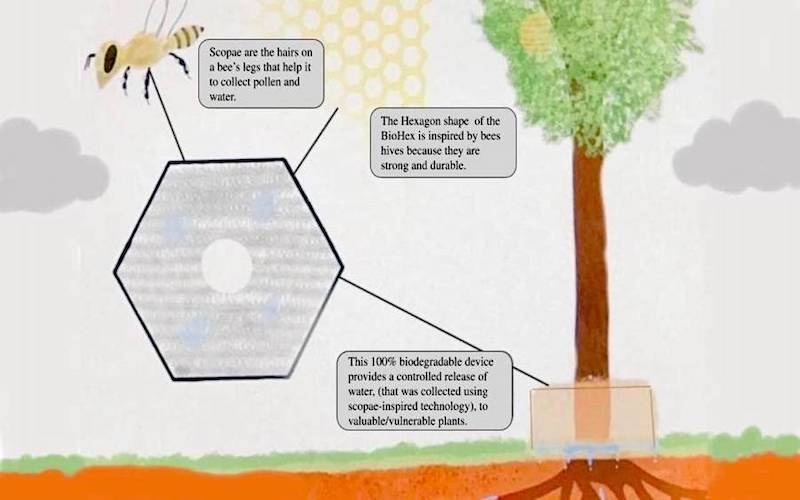
Design Statement: We as humans have evolved to cause so much harm to our planet. Our carbon emissions are heating up the earth, we are causing climate change and climate change is affecting everything. It even affects us in New Mexico directly, through drought. Drought doesn’t just hurt those you cannot drink the water, but those who eat plants that need that water, and animals that eat those animals. It is a vicious cycle and it is devastating for our ecosystems. The BioHex device will address drought and biodiversity loss directly.
The BioHex is an entirely biodegradable device that can collect water out of the air and provide a controlled release of it to vulnerable and valuable plants. It sits around a plant like a tree skirt so that it can get the water it has collected to the tree. The BioHex focuses on plants that are valuable to pollinators, for example apple trees, butterfly bushes, willows, lilacs, etc, during extreme drought periods. Using technology inspired by scopae (the hairs on a bee’s body) the BioHex may collect water out of the air. Scopae helps bees collect pollen off of flowers as well as to collect water to help them cool their hives. Speaking of hives, the BioHex is shaped like a hexagon because it is nature’s favorite and most efficient shape. It fills up space while using the least amount of surface area! We inspired the BioHex off of the hexagons that are found in bee’s hives. The texture on the sides of the BioHex are inspired by the Namib Desert Beetle. The Namib Desert Beetle uses texture on it’s back to collect water in the air and then direct it to its mouth. Using this technology the outer sides of the BioHex can pick up water and direct it to the ground for the plant to absorb. The Biohex helps provide water that would otherwise be inaccessible while still allowing the plants to collect their own water out of the ground. It will help get plants through the most extreme drought periods and then it will decompose into the earth, leaving the trees thriving and healthy, just as they should be. The BioHex also comes in many different sizes so it may support plants of different ages/variety. It uses no dyes or harmful materials so it will never hurt the earth in an attempt to save it. The BioHex absorbs carbon when it is still standing so that after it has decomposed it will release the carbon to be used by other organisms.
While the BioHex cannot stop global warming or climate change, it can help these trees and plants directly. Like an ally. The Biohex will defend our plants against the bully we call Drought. It cannot stop the bully, but it can lend a helping hand and comfort our plants through a tough time. BioHex is our ally. The BioHex focuses on plants that are valuable to pollinators, for example if there is a beehive in a certain tree, or a plant that is very important for pollinators by, for example, providing lots of pollen, the BioHex can help it last to be useful to the pollinators. Besides being important for pollinators, the BioHex is also very inspired by them! The hexagon shape of the BioHex is inspired by bee’s hives because it is very durable and strong. Scopae was what allowed us to make the BioHex work! By being biodegradable, the BioHex may do its job and then return to Earth, but even after it is done providing water to the plant, it still is helping the ecosystem by releasing carbon that may be used by others. Drought is still a major problem, but with the BioHex, we don’t have to worry as much about it affecting our extraordinary plants. BioHex, Our Planet’s Ally.
AquaBulb
Emma Atkinson, Karissa Winters & Violet Hay
Taos Charter School, Grade 7
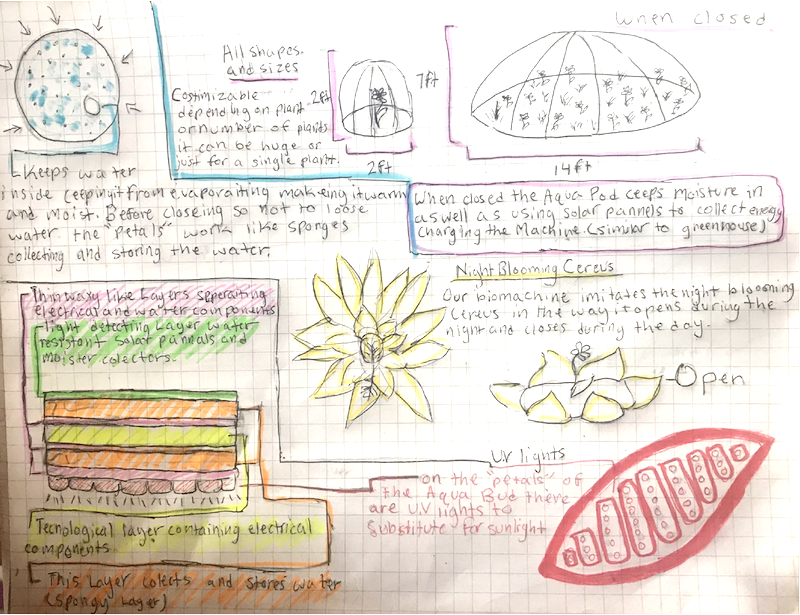
Design Statement: New Mexico is a place prone to drought which can lead to devastating blows to the farming community. Farming is an important way of income and it can be hard to farm during droughts. Our invention The Aqua Bulb is a device that protects plants from losing moisture. The biomachine closes around the plant like a flower bud to prevent moisture loss and protect it from the sun, so the plant doesn’t die. The machine has UV lights lining the inside of the petals so it does not die because of the lack of photosynthesis. It opens at night and during the day when it is most likely to get pollinated (1 or 2 pm). Before opening it gathers the moisture like a sponge keeping it in the petals until closed again then releasing the moisture back to the plant. When it opens it allows sunlight and pollinators to nourish the plant.
This biomachine will help farming, and the population of plants with its innovative adaptations based on the Night Blooming Cereus and the Rose butterfly. The machine design is based off of the Night Blooming Cereus and the Rose butterfly and is designed to help protect plants from drought. With this biomachine, plants will maintain more moisture and grow faster. The way that this machine closes its “petals” is quite similar to the way the Night Blooming Cereus does during the day and then opening up at night. This machine is eco friendly powered by the sun. With solar panels which are based on the wings of the Rose butterfly. On its “petals” the machine collects sunlight while keeping the plant moist. The solar panels are more efficient than regular solar panels because they can collect sun at all angles no matter where the sun is facing. It does this because of structure. The structure makes thin solar cells which are more efficient than thick solar cells. This machine will not only help one individual plant but it can help many different plants at once. We can do this by making it in different sizes that could cover a whole farming field. This machine is quite similar to the way a greenhouse works keeping a warm, humid climate inside of the bud, covering the plant. Our biomachine The Aqua bulb nourishes the plants and will help the plant grow faster and flourish. This could be beneficial to farmers and people all over the world as well as pollinators. This machine will have many benefits for our agriculture and will help cut down the use of water while dealing with drought.
The Unsighted Visual-inator
Taylor Donaldson
Taos High School, Grade 11
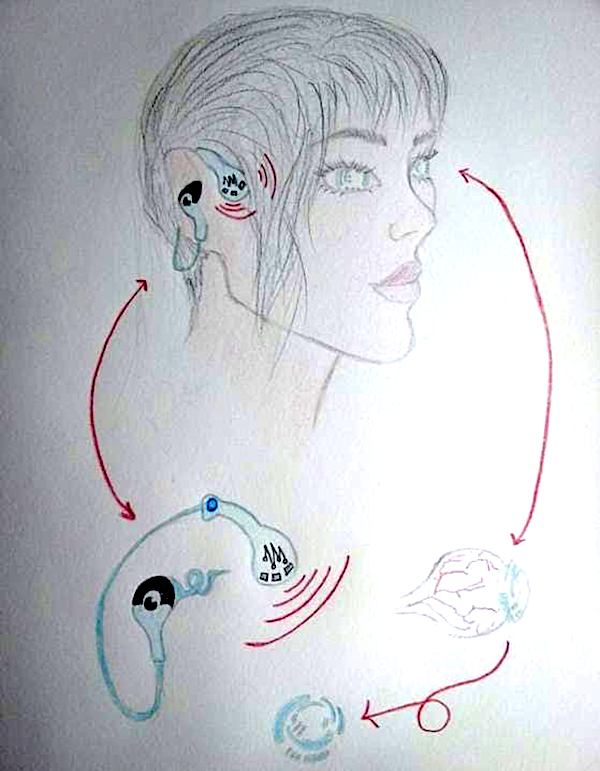
Design Statement: What my Biomachine solves is to see without the use of your eyes. Example it helps the blind to see, using the unsighted visual-inatior it uses echolocation by vibrations, and noises. So, your using your other senses to make up the one you lost. How you use it, you put both ear buds into your ears and put in the contacts in your eyes.There will also be a button on this device, when you press it, it sends out a high pitch sound that will bounce off of objects making vibrations to let the user see with his/her blind eyes. What inspired me to make this biomachine was a device called “bone conduction hearing device” it is a type of hearing aid, but it uses the bone behind the ear to hear. When you close your ears, you hear without your ears, while it’s on it feels like it’s coming from your forehead. When bats hunt, they use echolocation making it possible to see while pitch black, I want that for humans. The contact lenses containing data of different temperature, objects, areas and living things are throwing off. The temperatures having different colors like warnings and to know what it might be inspired by both butterflies and bats vision.
AquaPod
Joaquin Rose & Mateo Carmona Yong
Taos Charter School, Grade 7
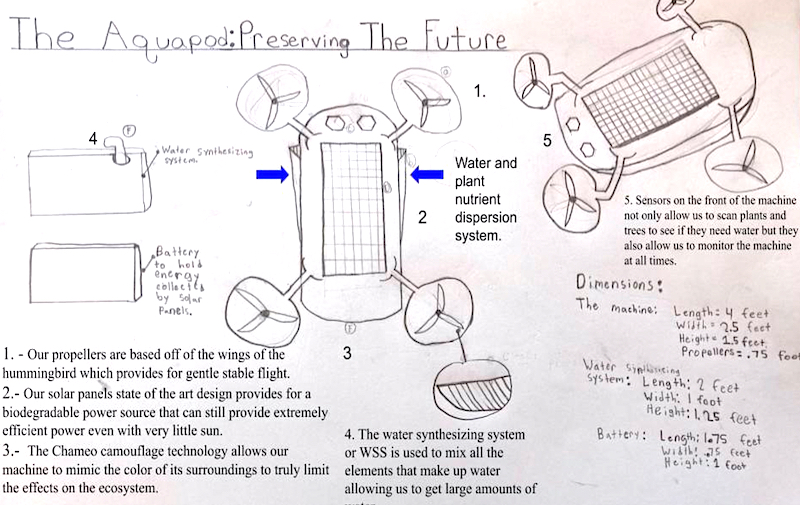
Design Statement: Imagine a time where there is never a fear of drought and the forests could be balanced year round. Even though it seems impossible, it isn’t, because of the ground-breaking invention of the Aquapod, drought will be a fear of the past. It combats drought-ridden ecosystems without leaving any negative impact on the surroundings. There is no production of harmful fuel or noise pollution and natural water sources are left untouched. Our design perfectly balances futuristic with simple and has been designed in the most versatile way possible. Everything about our biodegradable and innovative design is based on our goal, which is preserving the future. The Aquapod uses several enhanced animal adaptations combined with scientific engineering to help preserve ecosystems without hurting them. One of the Aquapod’s goals is to reduce the amount of carbon in the air while helping ecosystems out of extreme drought. To achieve this, we have developed technology that allows us to create water from oxygen and hydrogen that is extracted from methane from the atmosphere. Once the water is created within the machine, it is dispersed in the form of rain to struggling plants or trees that are in drought. All of these components come together to preserve and help ecosystems thrive by removing harmful greenhouse gases.
Each part of the Aquapod and every futuristic feature solves a problem of its own while still contributing to the main goal of combating drought. The Aquapod is powered by state of the art, biodegradable solar panels that are located on the torso of the machine, these are used to power our propellers as well as our water and plant nutrient creation system. But before we distribute that water and plant nutrients we use our newly developed sensors to distinguish trees and plants that are experiencing drought from ones that are doing fine. Our propellers are made from a durable but light material to provide for easy flying. We modeled them after hummingbird wings because of their unique ability to fly forward, backward, sideways, and straight up allowing the Aquapod to travel more efficiently while still being perfectly silent. To not disturb wildlife, our newly designed Chameo technology allows for our machine to blend in to its surroundings by changing its patterns, colors, and textures to match that of its environment. Just like how chameleons store different pigments to be used depending on their surroundings our machine does the same. We power all of these components from a battery that has a huge capacity and is extremely durable allowing us to fully charge the machine from very little sunlight. Every piece of our machine is not only fully biodegradable but it is also made of a very strong, light weight, durable, synthetic material, that way, in the event of it crashing or malfunctioning the remnants of the machine will not affect or change the ecosystem in any way. Every piece of the Aquapod was designed in which to leave little to no impact on the ecosystem as well as solving problems with innovative and futuristic technology. In the future, we hope to see lower temperatures, less drought, and thriving ecosystems due to the Aquapod’s efforts.
Flower Power
Marika Moyer, Dahnyell Martinez, Seth Danem
Taos High School, Grade 11
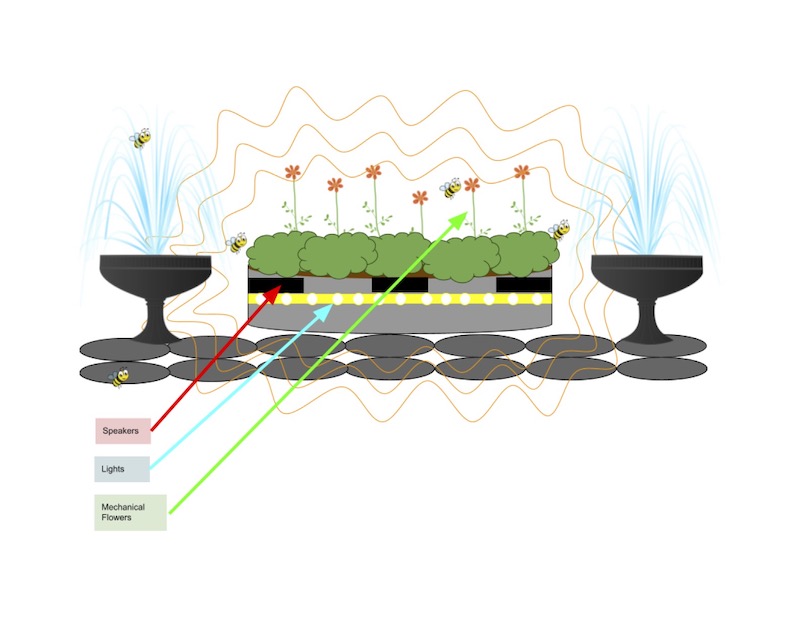
Design Statement: Bees play a huge role in our everyday lives even though we may not see it. If you actually take the time to study the lifestyle of these tiny creatures, you would be very surprised to find out just how important they really are. We all know bees make the honey us humans like to enjoy, but the pollination process is much more difficult than it seems. Bees have over 5,000 different ommatidia in their eyes which causes their vision to be blurry. When searching for flowers at a far distance, bees have a hard time navigating their way around. In order to make their job easier, we have decided to create a flower bed that supports these flaws. Our flower bed will contain lights so bees will be able to see using their strong color signals to ultraviolet, blue, and green lights. Communication will also play a role in our flower bed for bees to use vibration to communicate with one another. This being said, sound waves being sent off by vibrations will be transmitted off of the bed to attract more bees to the location. Not only will our flower bed be beneficial to bees and their pollinating jobs, it will also be an eco-friendly art like design for the enjoyment of our community. Bees will have an easier lifestyle and our community can enjoy creativity while learning about the wonderful creatures who inspired it.
Fractal Garden
Kaien Memmer
Taos High School, Grade 11
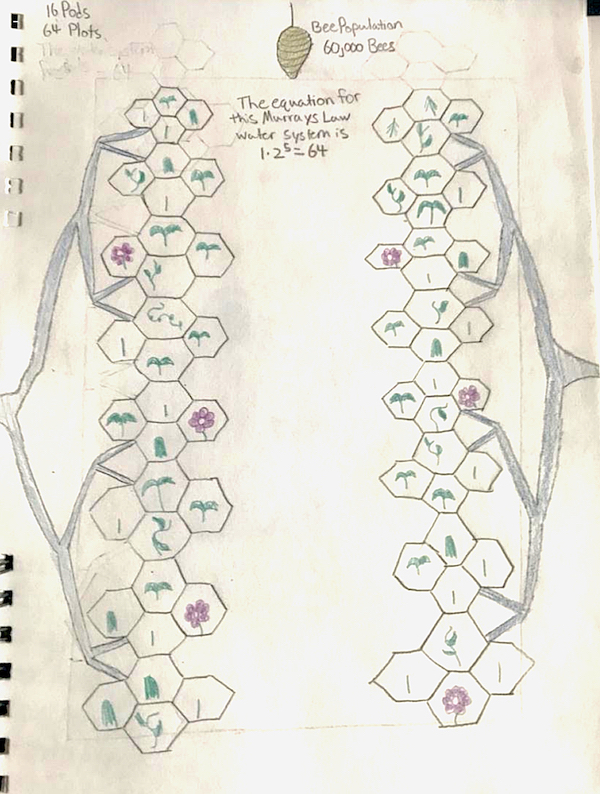
Design Statement: My project is a pollination garden that’s design is based in biomimicry. I first just wanted to make a garden for people to be able to get fresh produce from a local source. I then wanted to apply the use of bees to pollinate the garden, which isn’t hard you just make a bee population somewhere near the plants and as soon as the garden has flowers the bees find and pollinate them. While researching biomimicry and bee specific engineering, I decided to make my plots hexagons which are in pods of 4 to maximize use of area. The main mathematical focus behind my project was in the irrigation system. In my research I learned about Murrays Law and how nature found a way to perfectly distribute liquids in the most efficient way possible, so I wanted to use that in my garden design. Essentially, my irrigation system fractals out in increments of two five different times to bring water to all 64 of my plots, this is the same kind of water distribution that can be found in the vascular systems of both animals and plants. Other goals of the garden would be to raise awareness about the global bee problem, support the save the bees initiative via using bees directly to pollinate my plants, show how effective biomimicry can be, and to bring locally sourced produce to more people. My bio machine is a pollination garden that is fully based in biomimicry to maximize the efficiency of the garden and also to raise important awareness.
Bat Immune Drip
Gabriella Varos
Taos High School, Grade 9
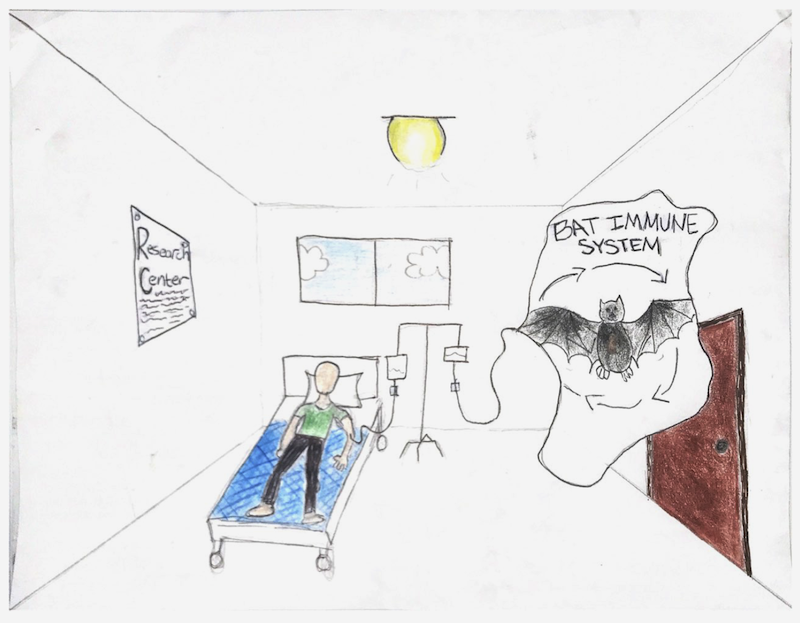
Design Statement: This BioMachine project pushed me to explore deeper into something I’m already interested in: viruses, specifically Covid-19. I obsess over the spreading of germs and this was part of me trying to cope with it. Bat’s unique immunity really caught my attention and from there, I began researching how bats immune systems work. Bats are not affected by viruses like humans or other mammals. They aren’t affected because of their special immunity that doesn’t initiate an inflammatory response. Although that inflammatory response in humans can be helpful when fighting off infections, it ends up fighting you with the virus. That’s what makes us as humans sick when we come into contact with the virus. The idea for this design is a new way of looking at viruses and the impact it has on humans at the root, the host. If we can mimic the way that bat’s immune systems react to viruses, we could have a new way of protecting humans from viruses. My drawn out idea is showing the connection of our immune systems to bat’s.
Butterfly Seeding Car
Amelia Caldwell
Anansi Charter School, Grade 7
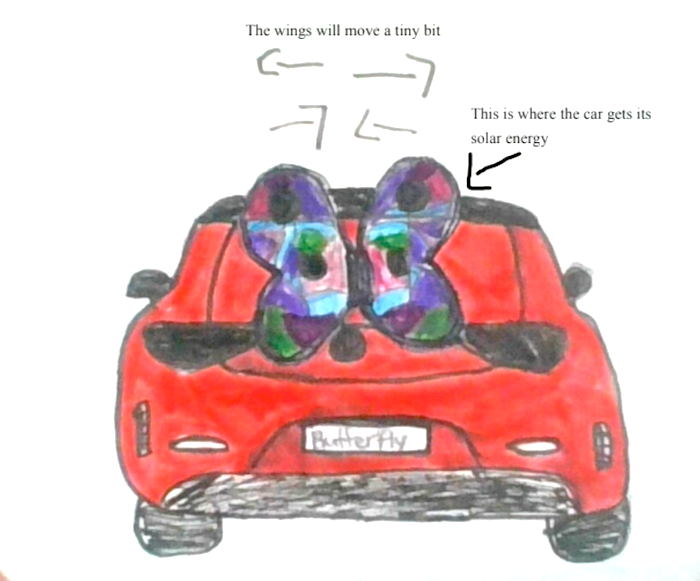
Design Statement: The BioMachine is a solar powered car and the solar panels are inspired by butterfly wings. My BioMachine will have a solar panel that has the design of butterfly wings and the solar panel will be shaped as wings and move like them. This car will have seeds in the tires so that we can plant seeds. This will plant flowers and help pollinators. On the STEMarts site I read “The wings of a butterfly have inspired a new type of solar cell that can harvest light twice as efficiently as before.”. My car helps because it plants flowers and since it is solar powered it is good for the environment because it doesn’t emit gas.
Indoor Bee Habitat
Rhiannon Montoya
TAFT Middle School, Grade 7
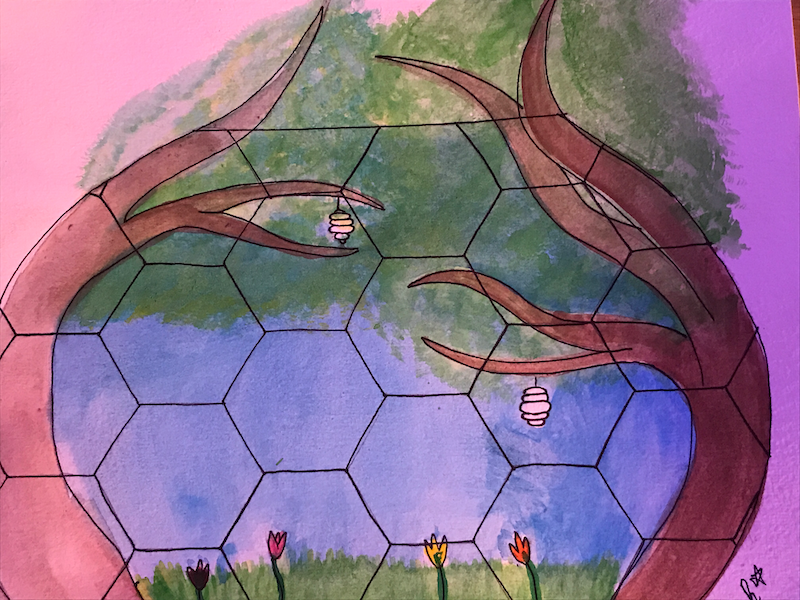
Design Statement: This BioMachine project pushed me to explore deeper into something I’m already interested in: viruses, specifically Covid-19. I obsess over the spreading of germs and this was part of me trying to cope with it. Bat’s unique immunity really caught my attention and from there, I began researching how bats immune systems work.Bats are not affected by viruses like humans or other mammals. They aren’t affected because of their special immunity that doesn’t initiate an inflammatory response. Although that inflammatory response in humans can be helpful when fighting off infections, it ends up fighting you with the virus. That’s what makes us as humans sick when we come into contact with the virus. The idea for this design is a new way of looking at viruses and the impact it has on humans at the root, the host. If we can mimic the way that bat’s immune systems react to viruses, we could have a new way of protecting humans from viruses. My drawn out idea is showing the connection of our immune systems to bat’s.
Justa Box
Sara Martinez
Taos Charter School, Grade 7
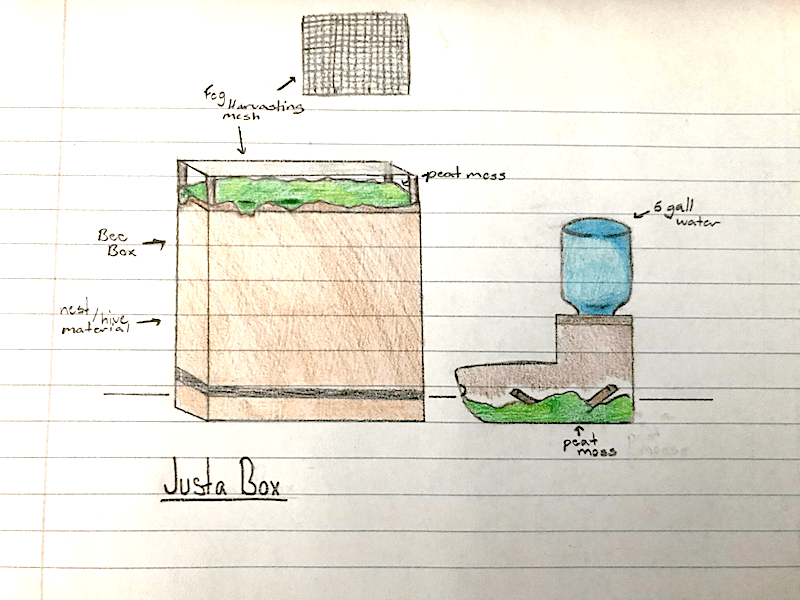
Design Statement: A lot of bees and their colones die during droughts due to the lack of water that is available, so the goal for my machine is to give bees a stable water source to help bees pollinate areas that need it.
My machine is basically a bee box with peat moss and fog harvesting mesh on top of it with a water station next to it that also has peat moss in it. The reason that it uses peat moss is because it is really good at holding in water and keeping it moist even on dry days. The mesh also helps with collecting water from things like fog and rain, it also helps with adding more water to the moss because as it collects water it will get heavier and eventually drip down onto the moss. The water station has the peat moss so that it collects water from the rain and the water jug on top. There are things like rocks and wood in it for bees to land on so they don’t drown, however there are drainage holes on it so it doesn’t get too full of water. Like I stated before the purpose of this project is to help and give bees a stable water source during drought.
In conclusion the main goal and reason for my machine is to give bees a stable water source so they can survive and pollinate an area that needs it and also help their hive survive. The machine is supposed to give the bees a water source that can collect and hold water even on hot days. The reason that I want my machine is to help bees and their hives during droughts and really hot days throughout the year.
Pollinator Sensation
Marlena Gerken and Simone Salazar-Bahrens
Taos High School, Grade 11
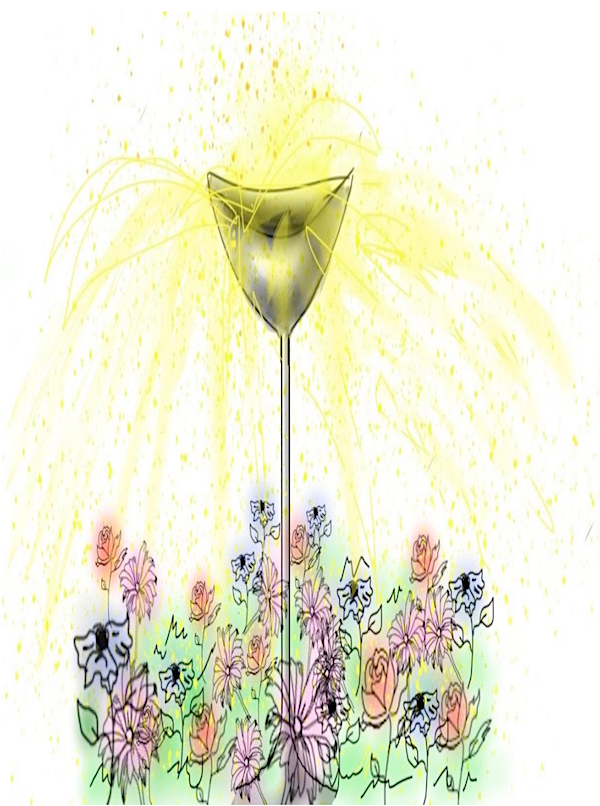
Design Statement: Our Bio Machine is a mechanical pollinator. This idea was inspired by all pollinators, however mainly bees. This machine would be able to fix many growing issues such as famished communities, the decrease in pollinator populations, and lack vegetation growth. Our Bio Machine is a self-sufficient garden with a mechanical pollinator. This machine would be portrayed as a wide bowl made out of metal that spins at a rapid pace. The machine would be filled with pollen and placed in the middle of a biodiverse field of plants. The machine would be turned on remotely and would accelerate in speed until the pollen jets out of the bowl and sprinkles the pollen all over the plants. The pollen would be harvested by removing an entire male flower cluster and placing it in a sealed storage container for several days. After the cluster has dried, it is placed over a micron screen with parchment or wax paper underneath, and a light shake will release the pollen. This is an artistic and visual way of pollination and is agriculturally sound. Since this machine acts as a pollinator it will allow a higher chance of production for plants to fruit, seed, and breed. With this kind of efficiency the pollinator could be a fix to those who do not have access to large food corporations. The machine could also increase local food production and be a sustainable food source. This could create a bio diverse ecosystem in a SELF sufficient garden, which would create a habitat for wildlife. Not only could this garden create a fix for third world countries, but it could also attract more pollinators, and would create an even richer environment for plant growth.

